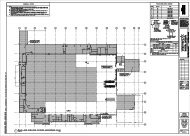PROJECT MANUAL Specifications Seafood Removal Walmart Store No 1186 Liberty TX
Specs - Home
Specs - Home
- No tags were found...
Create successful ePaper yourself
Turn your PDF publications into a flip-book with our unique Google optimized e-Paper software.
I. Install grease interceptors, including trapping, venting, and flow-control fitting, according to authorities having<br />
jurisdiction and with clear space for servicing.<br />
1. Install cleanout immediately downstream from interceptors not having integral cleanout on outlet.<br />
2. Connect inlet and outlet to unit, and connect flow-control fitting and vent to unit inlet piping. Install valve<br />
on outlet of automatic drawoff-type unit.<br />
J. Install traps on plumbing specialty drain outlets. Omit traps on indirect wastes unless trap is indicated.<br />
K. Install escutcheons at wall, floor, and ceiling penetrations in exposed finished locations and within cabinets and<br />
millwork. Use deep-pattern escutcheons if required to conceal protruding pipe fittings.<br />
3.5 PIPE FREEZE PROTECTION<br />
A. Install heating cable at locations shown on drawings for pipe freeze protection.<br />
B. Cut heating cable to length required for pipe lengths and watt per foot requirements. Secure to pipe and install in<br />
accordance with manufacturer's published instructions.<br />
3.6 PIPE TESTS<br />
A. Test underground piping prior to backfilling and before installing equipment and before insulation is applied, using<br />
specified methods and conditions. Subject piping to test for not less than 24 hours. Make necessary replacements<br />
or repairs and repeat tests until entire system, including equipment, is accepted as satisfactory.<br />
B. Install equipment, operate systems, clean out scale, dirt, oil, waste, and foreign matter, and correct additional leaks.<br />
C. Test plumbing drainage systems under 10 foot static head for a period of not less than 24 hours. Test water<br />
systems under 150 psig hydrostatic pressure.<br />
3.7 CLEANING AND DISINFECTION<br />
A. Clean and disinfect potable domestic water piping as follows:<br />
1. Purge new piping and parts of existing piping that have been altered, extended, or repaired before using.<br />
2. Use purging and disinfecting procedures prescribed by authorities having jurisdiction. If methods are not<br />
prescribed, use procedures described in AWWA C651 or follow procedures described as follows:<br />
a. Flush piping system with clean, potable water until dirty water does not appear at outlets.<br />
b. Fill and isolate system according to either of the following:<br />
1) Fill system or part thereof with water/chlorine solution with at least 50 ppm of chlorine.<br />
Isolate with valves and allow to stand for 24 hours.<br />
2) Fill system or part thereof with water/chlorine solution with at least 200 ppm of chlorine.<br />
Isolate and allow to stand for three hours.<br />
c. After the standing time, flush system with clean, potable water until no chlorine is in water coming<br />
from system.<br />
B. Submit water samples in sterile bottles to authorities having jurisdiction. Repeat procedures if biological<br />
examination shows contamination.<br />
C. Reports: Prepare disinfection reports signed by the authority having jurisdiction and submit to the Architect upon<br />
completion of the project.<br />
3.8 GREASE/OIL INTERCEPTOR TANK DYE TEST<br />
A. Perform dye testing on piping scheduled to be connected to the grease or oil interceptor and show evidence that all<br />
drains are properly connected to the correct interceptor.<br />
15100-8<br />
<strong>Walmart</strong> #<strong>1186</strong> - <strong>Liberty</strong>, <strong>TX</strong> 04/20/11<br />
CMA/10118.034



